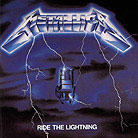May 2000
The first track, "Fight Fire With Fire," with its thrash style of guitars and drums pummeling the cranium, takes off from the style of Kill ‘Em All. Thereafter, the songs become more concise and systematically arranged. "Fade to Black," a metal anthem about suicide, displays Metallica’s ability to combine melody, speed, and intelligent lyrics. James Hetfield’s rhythm-guitar work throughout the album is fantastic. Together with Kirk Hammet on lead, the two play with ferocity and power, yet they never lose track of each other. The seventh track, "Creeping Death," has always been a show favorite, and for good reason. The arrangement is tight, fast, and features some of Kirk Hammet’s best guitar lines. "The Call of Kthulu," a nearly nine-minute instrumental that was later re-recorded with the San Francisco Orchestra on the S&M CD, is my personal favorite on the album. The song builds slowly and melodically, then climaxes in true Metallica fashion, all the while transfixing you to the rhythms of guitars, Lars Ulrich’s dynamic drumming, and one of Cliff Burton’s better bass lines. Overall, Metallica displays a lot more diversity in songwriting than their prior release. Pulsating drums, crunching guitars, dueling rhythms and melodic acoustic pieces all make this album an incredible achievement and advancement from Kill ‘Em All. Lyrically, the writing is also good. The material is on the angry and rebellious side, yet it speaks many truths about society. Steve Hoffman of DCC seems to have Metallica remasters down to a science. All through my notes, words like "weight," "foundation," and "depth" appear. The original release is notably thin and sterile, while the DCC release demonstrates that CDs are not necessarily constricted to wallpaper-like sound. In addition, the resolution of the instruments is improved, particularly on the cymbals and high hat. The soundstage overall does not have much depth except on the "Fade to Black" track. However, the recording is well balanced. One interesting thing to note is that the polarity of the recording is reversed compared to the original and import releases. DCC stated that they always use the original masters and always do a polarity check, so it is assumed that the original was polarity-challenged. Unlike some remasters, the improvements to the original are immediately obvious, and this album is easily recommended. GO BACK TO: |
 Metallica -
Ride the Lightning
Metallica -
Ride the Lightning![[Reviewed on CD]](../format/goldcd.gif) Metallica’s
Ride the Lightning was originally released in 1984 following Kill ‘Em All.
Since that time, Ride the Lightning has gone platinum five times by effectively
bridging the thrash sounds of Kill ‘Em All and the more intricate speed
compositions of Master of Puppets. This release foretells of the complicated
arrangements to be seen in Master of Puppets and features the last of Dave
Mustaine’s songwriting contributions.
Metallica’s
Ride the Lightning was originally released in 1984 following Kill ‘Em All.
Since that time, Ride the Lightning has gone platinum five times by effectively
bridging the thrash sounds of Kill ‘Em All and the more intricate speed
compositions of Master of Puppets. This release foretells of the complicated
arrangements to be seen in Master of Puppets and features the last of Dave
Mustaine’s songwriting contributions.